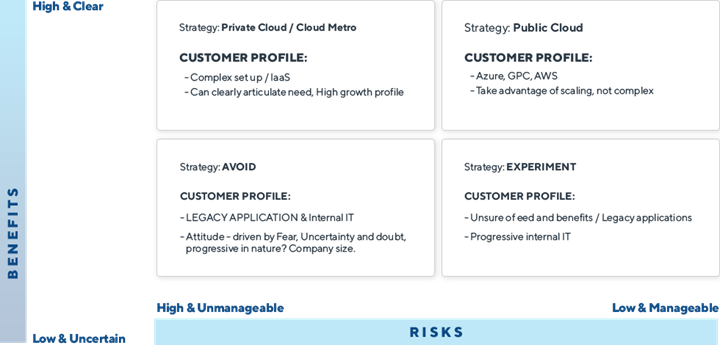When choosing the right type of cloud solution for your business, you need to consider a few factors.
First, you need to determine which type of cloud solution will best meet your needs – public, private or hybrid. Second, you need to assess your company's security needs and whether the cloud can meet them, you can think of this as risk. Finally, you need to make sure that the cloud provider you choose can offer the level of support and service that your business requires.
Public clouds are typically less expensive and offer more flexibility than private clouds. However, they may not be suitable for businesses with sensitive data or compliance requirements. Private clouds are better suited for businesses that require more control over their IT environment and data. They are also more expensive than public clouds.
Hybrid clouds offer the best of both worlds – the flexibility and cost-effectiveness of public clouds combined with the security and control of private clouds. So, what is hybrid cloud? They can be especially useful for businesses that are expanding into new markets or are looking to optimize their IT infrastructure.
When considering which cloud computing solution to choose, there are a few things to consider. For example:
Benefits:
Risks:
The graph below outlines how these risk/benefit scenarios can apply to the different types of cloud, and a business’ ability to manage them.

Scenario: If as an organisation you belong in an industry that is heavily regulated, such as Nimble in the short term loan financial space, then you will likely require a private cloud computing solution to ensure you adhere to compliance regulations around privacy of the customer’s financial data. These requirements vary considerably by country and sector.
Azure for Financial Services includes APRA-compliant financial service support software for Australian banks, insurance companies, and private equity groups that automates auditing requirements for Prudential Standard CPS 231 Outsourcing compliance. Enterprise businesses work through a financial services checklist to attain compliance with APRA Prudential Standard CPS 234 on Information Security and other industry requirements.
Scenario: If as an organisation you require shared online office applications to be rolled out across the company with members from multiple locations able to access items, such as a set of documents that need to be managed in real-time with multiple revisers, then a public cloud solution will be sufficient. Other businesses that would suit this model include new businesses who are not hampered by legacy systems and thus can approach their system as ‘cloud-first’, and those who are open to being innovative with their cloud service.
Hybrid cloud architecture based on software-defined networking (SDN) allows administrators to extend corporate firewall protection and filters to cloud resources. This includes support for SaaS/PaaS products under encryption through VPN connections. Hybrid cloud networking extends the availability of local resources through the use of cloud products, while enabling these services to be deployed or used in production with corporate security standards.
Scenario: If as an organisation you are unsure as to whether you require a cloud computing solution, and there are no clear benefits for your organisation, then it is not recommended that you don’t make the move to the cloud until you have determined what those benefits are. For example, if you are the Reserve Bank of Australia (RBA), there is a high level of risk when making the transition to a hybrid cloud solution – just one perception might be that the public cloud aspect of a hybrid cloud model could be construed as too great a liability for the sensitive information held by the RBA. In addition, the benefits of moving to a hybrid cloud solution could by some be disseminated to solely a cost-saving exercise, and so the perceived risk would be too high for the potential benefit. In terms of the RBA this is a broad case scenario only, as there are many nuances involved in the level of risk and potential benefit for such an organisation –and indeed for any organisation of this size, whether private or public –, however for a governmental institution the issue is not only the actual risk, but also the perceived risk by the public.
When preparing an internal audit of a company’s IT resources, it is recommended to plan for the operations of your company three to four years in the future. In this manner, it is more evident how to schedule legacy software applications and databases for modernisation through containers and cloud platforms, or to replace legacy hardware upgrades with cloud data center resources in product cycle management, while retaining current budgetary expenditure levels.
Scenario: If as an organisation you have high on-site premise maintenance costs and are thinking of making the move to the cloud, but aren’t sure which cloud service best suits your business’ needs both now and in the foreseeable future, it’s worth experimenting to try out which solution would best suit your business. Industries that have been disrupted and are playing catch up may try to jump here to defend market position and remain relevant.
It’s also important for businesses to keep in mind that you don’t need to choose a single environment when making the move to cloud computing – you can use a combination of environments to achieve the best results based on the various workloads and requirements you manage. The hybrid cloud approach allows you to choose the best service providers for every department, brand, and vertical, integrating IT resources in a unified corporate security policy.
If the above article has got you thinking about which is the right approach for your organisation, perhaps a conversation with one of your solution architects could be the next step? Our approach to helping organisations realise the right-fit cloud strategy for them starts from first understanding their goals and operating environment. Through conversation and consultant we can help you define and execute the right approach, that helps your business perform today, and be ready for the future.